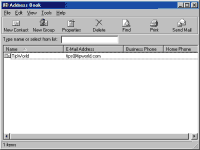
Outlook Express
Store email addresses in the Address Book
Outlook Express has a built-in address book, you don't have to memorize any email address. Click on
To add an entry simply click on New Contact, now fill in each field: First, Middle and Last name Nickname (use this to identify the person), type an email address and press Add
A person can have more than one email address, simply type the other email address
and click Add, You have to specify the default email address -this is the address you'll
be using to contact the person most often - select the email address and press
Set as Default. You can store additional info e.g Home and Business address, notes.
 Just select the tab and fill the fields
with the required information, when you finish data entry
press OK.
Just select the tab and fill the fields
with the required information, when you finish data entry
press OK.The person's name is immediately added to the address book window.
note: we'll talk later about NetMeeting and Digital IDs.
The Address Book window features three basic columns:
Name, Email Address, Business Phone and Home Phone.
To modify any contact information, simply select the person's listing and press Properties or double-click, make your changes and press Ok.
To delete entries from address book simply select and press Delete
You easily send messages directly from Address book, simply select a name and press
on Send mail icon. The message window opens, with the person's email address, type the subject and message and proceed as usual.
As you add entries, finding an email address, or contact info will get harder.
Use Find to locate any entry in the Address book. Type a name, phone, email
and press Find Now. You can also type a name in the Address book field.
Use Properties to modify contact info without leaving Find People window, even delete
an entry, when you're done click Close.
Find People feature let you search for email addresses on the internet, find a lost relative, or friend living abroad. In Find window click on Look in drop down menu
and select any email directory from the list e.g Yahoo People Search, InfoSpace
Sites like Yahoo and InfoSpace allow everyone to register an email address online,
many people go there and submit their names, addresses and emails.
Outlook Express uses those directories to search for a specific email name, home address, and maybe give you the results you expect.
Many people found lost relatives using those email Directories.
If you didn't find anything in one directory select another maybe it will yield something.
When searching online, you need to connect to your ISP, the Dial-up connection will pop-up when you click Find Now, just press Connect.
You can have a printout of all entries in your address book, simply press
You can use the Address Book with other applications, suppose you're working in Notepad and wanted to include a person's contact info: select the entry in the address
book, click Edit>>Copy, go back to NotePad and select Edit>>Paste or press CTRL V
If you're not comfortable with your current Address book, you easily modify its layout from View menu: Use large icons to display contact info, Sort entries by Name, email,
eliminate the Toolbar and Status bar.
Note: The Status bar is quite informative, just click on any command menu and see
a short description of that command on the status bar.
While surfing the Internet, you might discover other websites that provide an Email Directory services and you might want to use them in Outlook express.
In Address Book click Tools>>Accounts, click Add...
Make sure you have the server name something similar to ldap.bigfoot.com this is called LDAP (Lightweight Directory Access Protocol), in most cases you'll find all info on the Directory's website. Click Properties to make changes. We will discuss Email Directories later.
If you want more information about a topic or want to check the application's version, click Help menu.
It's always useful to add your own name to the Address book, press New Contact
and fill the form with your contact info. This will serve as your business card and
you can send it with every email message.
Soon, your Address Book will get crowded with email addresses, sometimes you might want to send the same message to many people, it would be inconvenient to add email addresses individually.
Outlook Express allows you to create so called Groups
Create a group e.g My Friends and add all your friends email addresses, so every time you want to send your friends a message, you can send it to My Friends Group and Outlook Express will automatically send the same message to all email addresses listed under this group. Create a group once and use it always, you will never waste your time adding individual email addresses to the message.
Click New Group, remember that you can only add emails that are already in your contact list, press Select Members select a Name and press Select -> when you're done press Ok
If the name is not in your Address book press New Contact, fill the contact form, when
you finish, the name is automatically added to the group.
You can always Remove a name from the list, even make changes with Properties,
no need to go back to the Address book contact list.
When specifying a Group name use something informative like My Friends,Colleagues...
In Notes field you can type a description, more info about the Group.
To send an email to the group members select the Group from Address book and click Send mail.